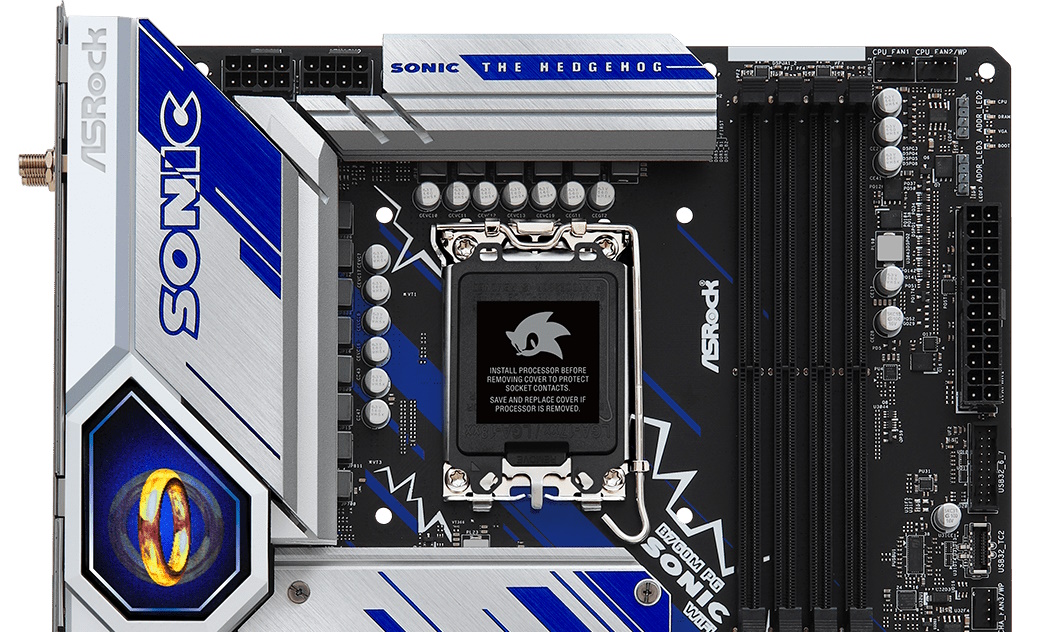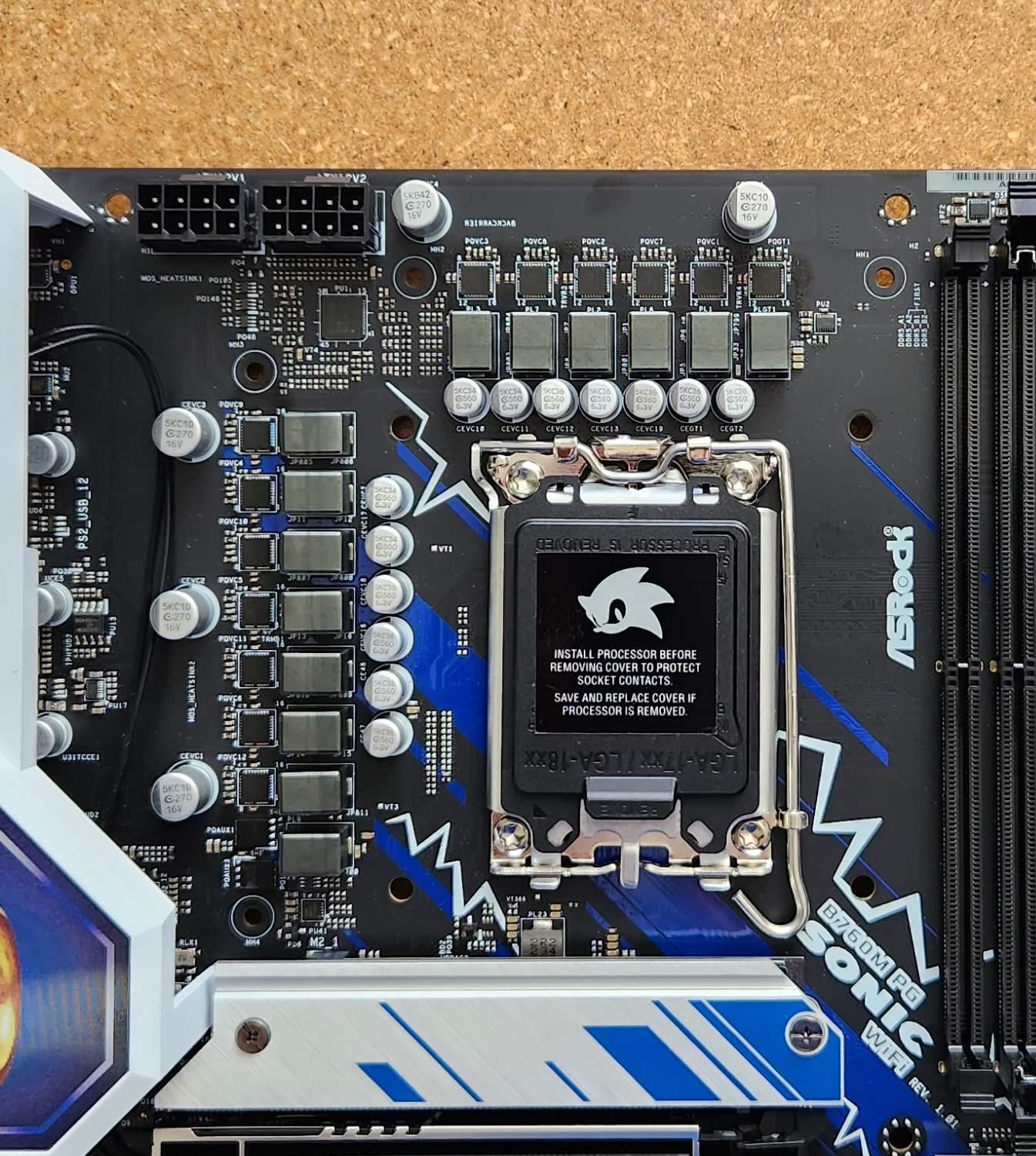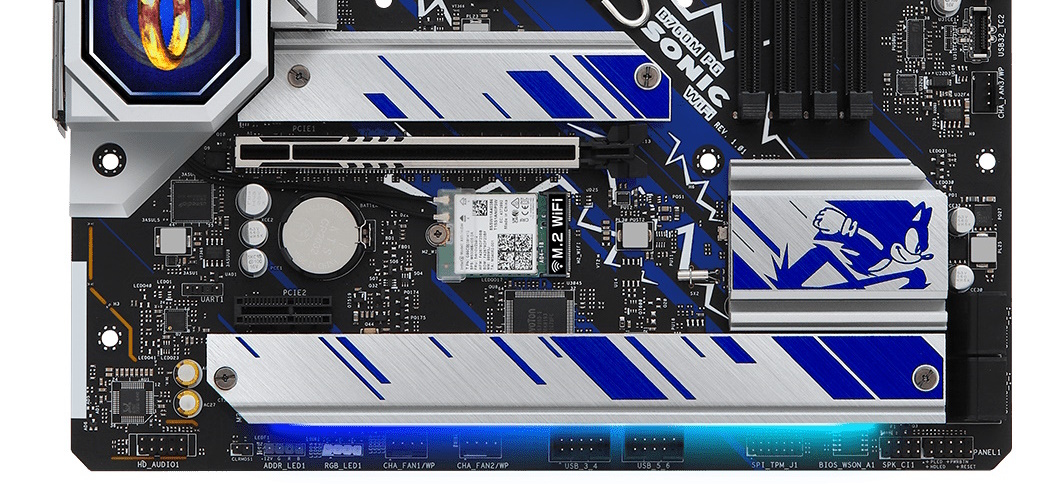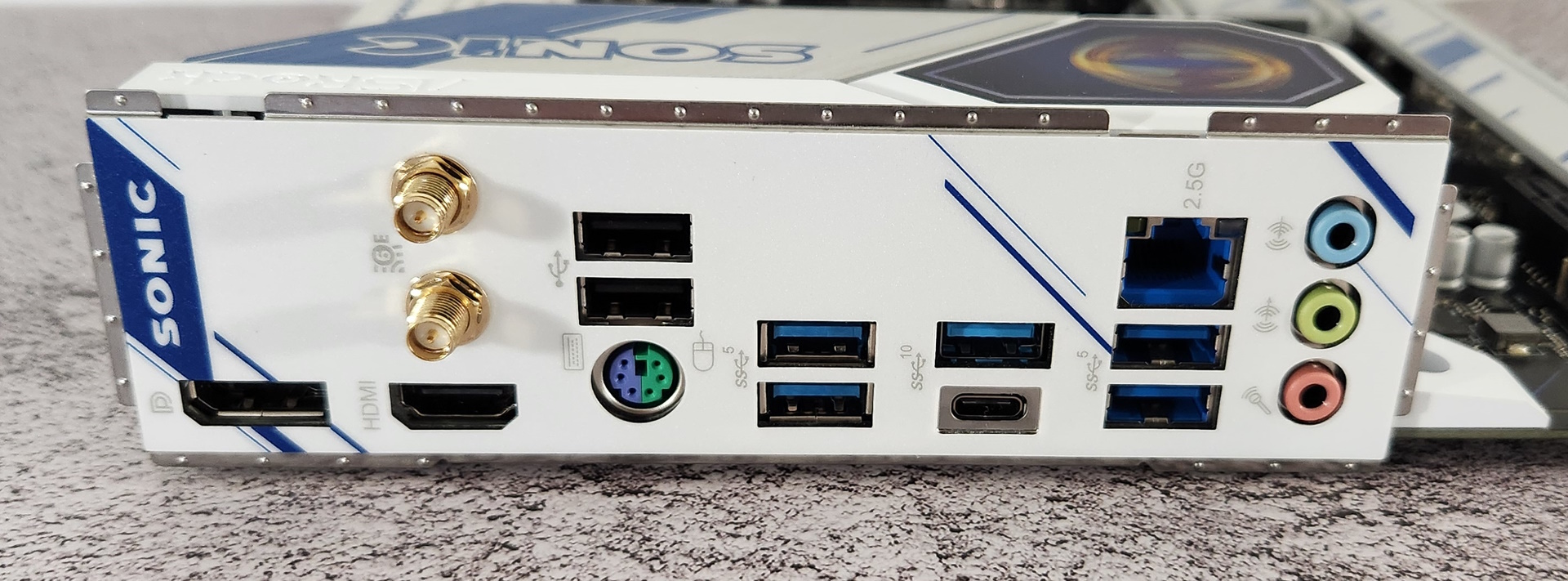Tom's Hardware Verdict
ASRock’s $189.99 PG Sonic Wi-Fi presents itself as a value-focused board sporting a unique Sonic the Hedgehog theme. It has most of what you’d want from an entry-level Micro-ATX board, including support for the latest flagship-class processors. Just be aware that performance was limited in heavily multi-threaded tests and long-running workloads out of the box with our i9-13900K.
Pros
- +
Sonic the Hedgehog theme
- +
Unique eDP port for monitors
- +
Well-rounded for the price
Cons
- -
Intel default performance out of the box
- -
Just 8 USB Ports
- -
Lacks 20 Gbps USB port(s)
- -
Theme limits broader appeal
Why you can trust Tom's Hardware
Our first review covering Intel’s budget B769 chipset is a unique-looking board from ASRock, called the B760M PG Sonic Wi-Fi. It’s a Micro-ATX motherboard and sports a Sonic the Hedgehog theme. The budget-class motherboard costs $189.99 at Newegg, which is on the high-end of B760. For the money, you get the distinctive Sonic design cues, three M.2 sockets and four SATA ports, a Realtek 2.5 GbE port and integrated Wi-Fi 6E, plus paltry but capable power delivery. In all, it’s a well-rounded option in the sub-$200 space, though you’d probably only purchase it if you’re a fan of the spinning blue hedgehog.
The most prominent feature is the collaboration with Sega, featuring the star of iconic 90s console games and an ongoing family movie franchise. All over the board and heatsinks are licensed features that Sonic lovers love to see. It has a spinning 16-bit ring on the left VRM bank, with blue and silver accents all around, including Sonic himself on the chipset heatsink. If you aren’t a Sonic fan, but the price point and features are right, you can find its twin (by specifications), the B760M Steel Legend Wi-Fi with a less polarizing appearance, for $20 less.
Hardware-wise, the B760M PG Sonic Wi-Fi compares well against the similarly priced competition. Some use DDR4 and offer a less expensive way into the platform, but are otherwise similar. They all have "good-enough" power delivery on paper, four SATA ports, at least two M.2 sockets (don’t expect PCIe 5.0 sockets at this price point), and an acceptable but undoubtedly budget audio codec. Those who need more than 8 USB ports on the rear of the motherboard should look to a competing alternative to the Sonic board.
On average, our tested B760M Sonic performance was slower than most other Intel boards we’ve tested. This happens because, by default, it sticks with the Intel power limits for our processor. You get the full 250W+ boost for a short time, and then it drops to the 125W–limiting performance. If you want to get the most out of this board and a flagship-class processor, you’ll need to adjust things in the BIOS and, by ASRock’s recommendation (which we agree with), active cooling for the VRMs and appropriately sized liquid cooling for the processor.
Below, we’ll dig into the details of the board and see whether Sonic will spin his way onto our Best Motherboards list. Before we get into our testing and board details, though, we’ll start by listing the specifications.
Specifications: ASRock B760M PG Sonic Wi-Fi
| Socket | LGA1700 |
| Chipset | B760 |
| Form Factor | Micro-ATX |
| Voltage Regulator | 14 Phase (12x 50A MOSFETs for Vcore) |
| Video Ports | (1) HDMI (v2.1) |
| (1) DisplayPort (v1.4) | |
| (1) eDP (v1.4) | |
| USB Ports | (1) USB 3.2 Gen 2 (10 Gbps), Type-C |
| (1) USB 3.2 Gen 2 (10 Gbps) | |
| (4) USB 3.2 Gen 1 (5 Gbps) | |
| (2) USB 2.0 (480 Mbps) | |
| Network Jacks | (1) 2.5 GbE |
| Audio Jacks | (3) Analog |
| Legacy Ports/Jacks | ✗ |
| Other Ports/Jack | ✗ |
| PCIe x16 | (1) v5.0 (x16) |
| PCIe x8 | ✗ |
| PCIe x4 | ✗ |
| PCIe x1 | (1) v4.0 (x1) |
| CrossFire/SLI | ✗ |
| DIMM Slots | (4) DDR5 7200+(OC)*, 192GB Capacity |
| *1DPC 1R Up to 7200+ MHz (OC), 4800 MHz Natively. | |
| 1DPC 2R Up to 6000+ MHz (OC), 4400 MHz Natively. | |
| 2DPC 1R Up to 5600+ MHz (OC), 4000 MHz Natively. | |
| 2DPC 2R Up to 4800+ MHz (OC), 3600 MHz Natively. | |
| M.2 Sockets | (3) PCIe 4.0 x4 (128 Gbps) / PCIe (up to 80mm) |
| SATA Ports | (4) SATA3 6 Gbps (Supports RAID 0/1/5/10) |
| USB Headers | (1) USB v3.2 Gen 2, Type-C (10 Gbps) |
| (1) USB v3.2 Gen 1 (5 Gbps) | |
| (2) USB v2.0 (480 Mbps) | |
| Fan/Pump Headers | (5) 4-Pin (CPU, CPU/Water Pump, Chassis/water pump) |
| RGB Headers | (3) aRGB (3-pin) |
| (1) RGB (4-pin) | |
| Diagnostics Panel | (1) Post Status Checker (4 LEDs) |
| Internal Button/Switch | ✗ |
| SATA Controllers | ✗ |
| Ethernet Controller(s) | (1) Realtek Dragon RTL8125BG (2.5 GbE) |
| Wi-Fi / Bluetooth | 802.11ax Wi-Fi 6E |
| USB Controllers | ASMedia ASM1074 |
| HD Audio Codec | Realtek ALC897 |
| DDL/DTS | ✗ / ✗ |
| Warranty | 3 Years |
Inside the Box of the ASRock B760M PG Sonic Wi-Fi
Inside the packaging, above the motherboard, are a small handful of accessories. ASRock includes a manual, two SATA cables, Wi-Fi antennas and screws and standoffs for the M.2 sockets. There isn’t much here, though the basics are covered.
Design of the ASRock B760M Sonic Wi-Fi
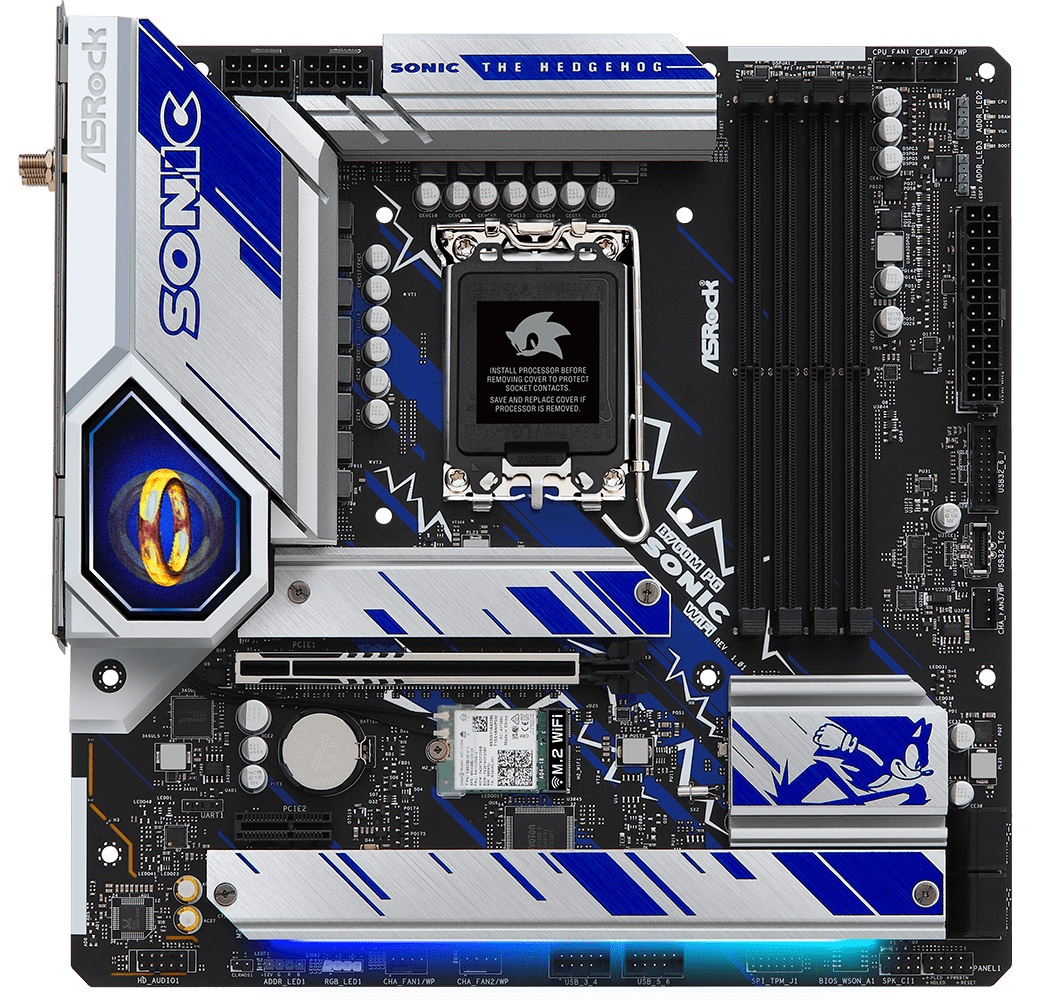

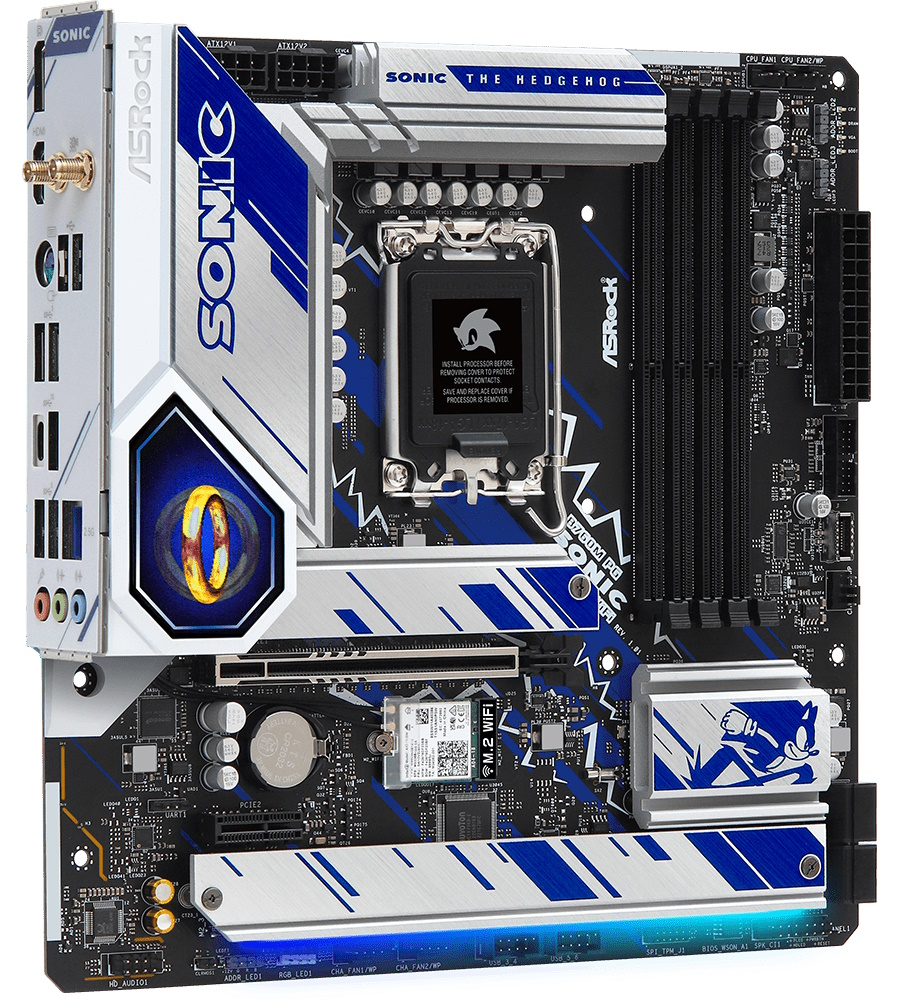
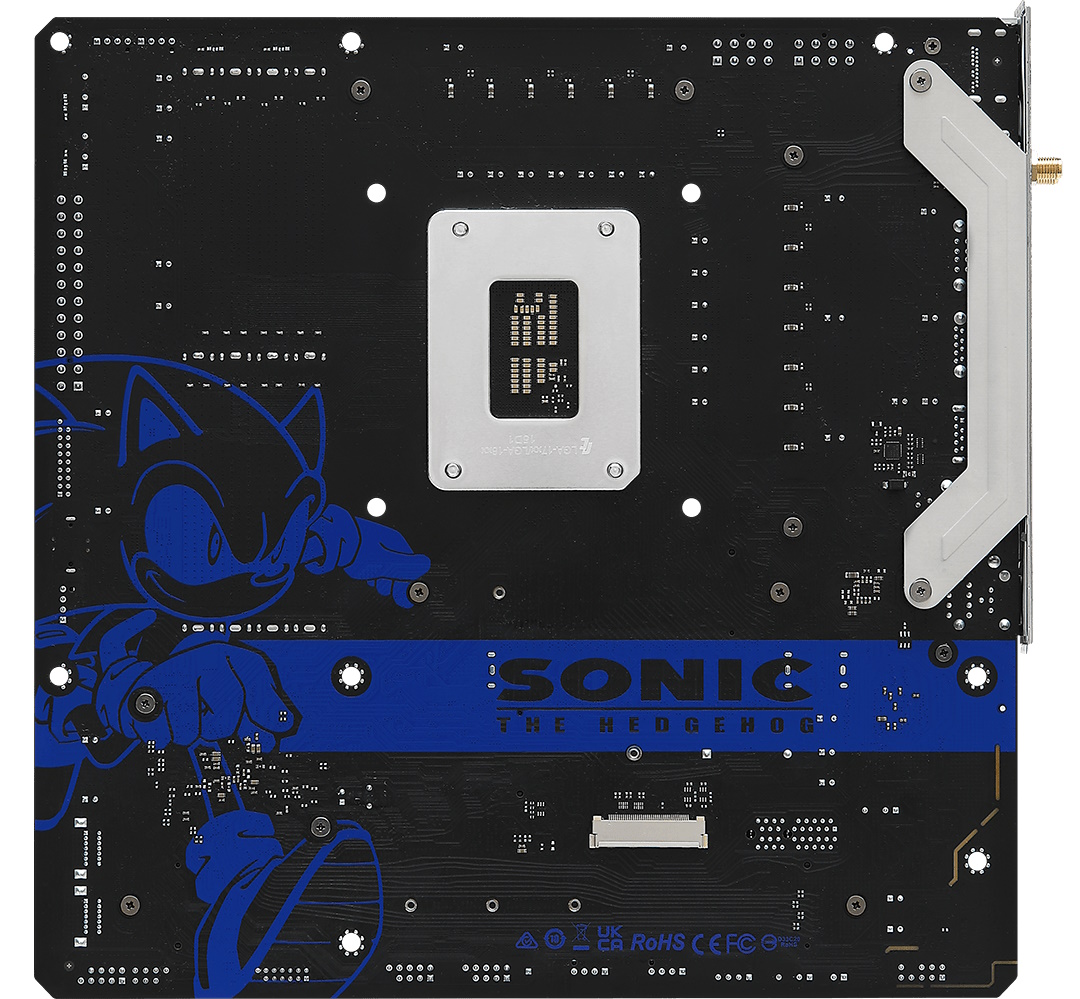
The ASRock B760M PG Sonic sports a matte black PCB along with white and blue sonic highlights (there are also some Sonic designs on the back of the board). All heatsinks are silver, with a brushed aluminum finish to accompany the blue Sonic design. On the IO cover is a hologram of a ring from the Sonic games that spins as the angle of your eye changes. The board also has integrated RGBs hidden below the long M.2 heatsink across the bottom to illuminate your chassis. The lighting was bright, and the colors saturated. The Polychrome RGB software allows you to customize the light show.
Without a doubt, the Sonic-themed board’s appearance is polarizing. Either you're a Sonic fan and the look is for you, or it isn’t. The good news is that there are other options available, including the B760M Steel Legend, which has the same hardware and features but opts for a black and silver design that will fit in better with more builds.
Get Tom's Hardware's best news and in-depth reviews, straight to your inbox.
Starting in the upper-left corner of our board tour, we get a better look at all of the Sonic the Hedgehog designs on the heatsinks. The left VRM bank sports the Sonic name in blue on the brushed aluminum heatsink, along with a hologram sticker of a ring that appears to spin as you look at it from different angles. Just above the heatsinks are two 8-pin EPS connectors (one required) to power the CPU.
Moving right past the socket, we run into four DRAM slots with locking mechanisms on both sides. ASRock lists memory support up to DDR5-7200+(OC), which is smoking fast for a budget platform (and fitting for the character). I don’t see many users going with such fast RAM with this platform, but since B760 alolows for overclocked memory (but not the CPU), there’s a fair amount of headroom for play. Using the fastest sticks we have available, 2x16GB DDR5-7200 CL34, the system ran stable during our stress test.
We run into the first two (of five) 4-pin fan headers in the upper-right corner. Each header supports PWM and DC-type devices, with CPU__FAN2/WP and CHA_FAN1-3/WP able to auto-detect the fan type. CPU_FAN1 supports up to 1A/12W, with the rest of the headers outputting up to 2A/24W. There’s plenty of power available for your fans and pumps here.
Shifting focus down the right edge, we run into the 4-LED POST Status Checker that lights up during the POST process. If the system hangs in one of the four areas (CPU, VGA, BOOT, RAM), the corresponding LED remains lit, giving users a general idea of where the problem is. Next is the 24-pin ATX connector to power the board, a 19-pin USB 3.2 Gen 1 (5 Gbps) header, a USB 3.2 Gen 2 (10 Gbps) header and, lastly, another 4-pin fan header.
Power delivery on our Sonic the Hedgehog-themed board is configured as 14 total phases, with 12 dedicated to Vcore. Power comes from the 8-pin EPS connector and heads down to the Richtek RT3628AE 9-channel PWM controller. Power moves to the 12 50A Vishay Sic634 MOSFETs in a Teamed configuration. The 600A available isn’t a lot, but, it handled our Intel i9-13900K without issue out of the box. And since you can’t overclock on this platform, it’s fine for stock operations.
On the bottom half of the Micro-ATX board, on the left-hand side, we see the audio section and the Realtek ALC897 codec, along with two dedicated audio capacitors. The codec is a bit dated and on the budget side, keeping costs down. Critical listeners may want to use a separate sound card or third party DAC, but many will find this solution adequate.
A couple of PCIe slots are in the middle of the board, along with three M.2 sockets and the Intel Wi-Fi card in the Key-E socket. The reinforced top full-length PCIe slot (primary graphics) is attached through the CPU and runs at PCIe 5.0 x16 speeds. The small x1 slot sources lanes from the chipset and runs at PCIe 4.0 x1 speeds.
Hiding under the Sonic heatsinks are three M.2 sockets. These sockets support up to 80mm modules and run up to PCIe 4.0 x4 (64 Gbps) speeds. The top socket connects through the CPU and the bottom two from the chipset. Along the right edge, we find four SATA3 ports supporting RAID0/1/5/10 modes (RAID doesn’t appear to be supported for M.2 sockets).
On the back of the B760M PG Sonic is a unique connection called Embedded DisplayPort (eDP). As the name implies, the eDP connector is for an LCD monitor that supports eDP. This connector supports eDP 1.4 and a maximum resolution of FHD (1080p) at 60 Hz. ASRock’s 13.3-inch side panel kit is the perfect accessory for this connector.
Across the bottom of the board are several exposed headers. You’ll find the usual, including additional USB ports, RGB headers, and power/reset buttons. Below is a complete list from left to right.
- Front panel audio
- Clear CMOS jumper
- 3-pin ARGB header
- 4-pin RGB header
- (2) System Fan headers
- (2) USB 2.0 headers
- Clear CMOS jumper
- TPM header
- Speaker header
- System panel header
The rear IO plate on the B760M PG Sonic comes preinstalled to the motherboard. The Sonic branding makes its way here, too, with a white and blue theme. There’s a total of eight USB ports scattered across the rear IO. You get two USB 3.2 Gen 2 (10 Gbps) ports (Type-C and Type-A), four USB 3.2 Gen 1 (5 Gbps) ports, and two USB 2.0 (480 Mbps). For video, the PG Sonic has HDMI and DisplayPorts (and the eDP port on the back of the board) for those with non-KF chips who don’t want to use a graphics card. Last are the 2.5 GbE port, Wi-Fi connectors, and the three 1/8-inch outputs that comprise the audio stack.
MORE: Best Motherboards
MORE: How To Choose A Motherboard
MORE: All Motherboard Content

Joe Shields is a staff writer at Tom’s Hardware. He reviews motherboards and PC components.
-
atomicWAR Its an okay board for micro atx board...functional but not extraordinary . Wouldn't be my first choice but for those gamers on a tight budget it seems like a solid enough choice for a micro build.Reply -
Co BIY I understand the need to test these with the i9 for consistant comparable results.Reply
But putting in an i5 and seeing how much you can get for how little is the purpose of these boards and deserves testing too. -
ocer9999 For the price this is actually a good choice. I just personally love the design... growing up around Sonic gaming... :DReply
